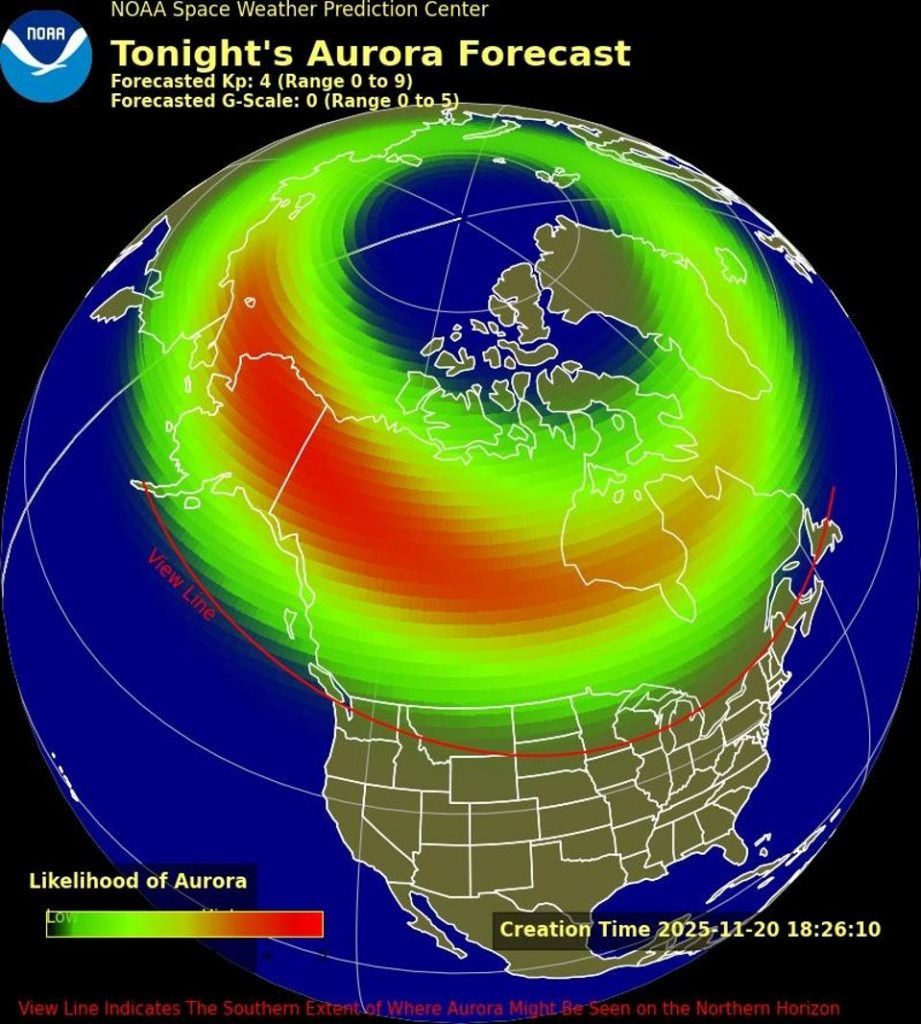There are never any guarantees, but the Northern Lights may be faintly visible in northern skies across 11 U.S. states and Canada after dark on Thursday, Nov. 20, according to a forecast from the National Oceanic and Atmospheric Administration’s Space Weather Prediction Center.
It comes in the wake of several displays in recent weeks, the most impressive being when red and green auroras were seen overnight on Tuesday, Nov. 11 from every U.S. state. That came after a rare ground level enhancement after an X-class solar flare.
Northern Lights Alert: What To Expect
The latest forecast calls for a “unsettled to active levels” of geomagnetism after dark in North America on Thursday, Nov. 20, stretching into the pre-dawn hours of Friday, Nov. 21.
NOAA predicts that “by mid to late on 20 Nov, a negative polarity CH HSS is expected to
become geoeffective causing a minor enhancement in the solar wind.” That refers to turbulence in the solar wind.
The Northern Lights are caused by the solar wind — streams of charged particles flowing from the sun and interacting with Earth’s magnetic field. While most are deflected, some particles spiral along magnetic field lines toward the poles, colliding with oxygen and nitrogen atoms high in the atmosphere. These collisions excite the gases, causing them to release energy as colored light.
Northern Lights Forecast: Where And When
NOAA’s latest aurora viewlines indicate that aurora displays are a possibility in northern U.S. states and Canada, with 11 U.S. states having a chance after dark on Thursday, Nov. 20.
U.S. states that may see aurora include Alaska and (northerly parts of) Washington, Idaho, Montana, Wyoming, North Dakota, South Dakota, Minnesota, Wisconsin, Michigan and Maine.
To check the latest forecasts, use NOAA’s 30-minute aurora forecast and apps such as Aurora Now, Space Weather Live, My Aurora Forecast and Glendale Aurora. A useful way to see what may soon become visible in North America is to check aurora webcams around the world.
For the best views, locate a dark place using the Dark Sky Place Finder and a light pollution map.
How To Predict The Northern Lights
Although aurora-chasers typically use the Kp index to predict the intensity of a geomagnetic storm, in practice the interplanetary magnetic field’s Bz component is more important. You’ll find it on aurora apps. When Bz points north, Earth’s magnetic field resists the solar wind, but when Bz swings south, the two fields connect, allowing plasma to stream in. A sustained southward Bz of −5 nT or stronger usually signals an imminent display of aurora.
Northern Lights Forecast: How To Photograph Aurora
A mirrorless or DSLR camera is ideal (ISO 1600, 2-10 seconds, f2.8), though newer smartphones are increasingly capable of stunning results. If your smartphone has a Night Mode or Pro Mode, you can capture a beautiful aurora photo with these steps:
- Use your main lens, not the ultra-wide, for sharper results.
- Stabilize the camera using a tripod or rest it on a firm surface such as a car roof, wall, or post.
- Shoot in RAW format if available, as it allows easier post-editing.
- Use long exposures between five and ten seconds. Even faint glows that look grayish to the eye often appear vividly green, purple or red in photos.
Wishing you clear skies and wide eyes.

